info@gerb.com
Withstanding past and future earthquakes with a 3-D Base Control System in California
David Lowe Residences, USA
The famous and award-winning american architect David Ming-Li Lowe (1954-2013) designed and built two identical buildings
with 3-story steel braced frame structures located in West Los Angeles. The architect’s own home, built in 1990, is a masterpiece
of residential design utilizing industrial technology and components. The building dimensions are approximately 12.8 x 12.8 m in plan, with a height of about 9 m. During the initial design the seismic mass was assumed with 62.5 metric tons. David Ming-Li Lowe designed buildings that were earthquake resistant and for these two current residences he introduced and applied the GERB 3-D Base Control System (BCS).
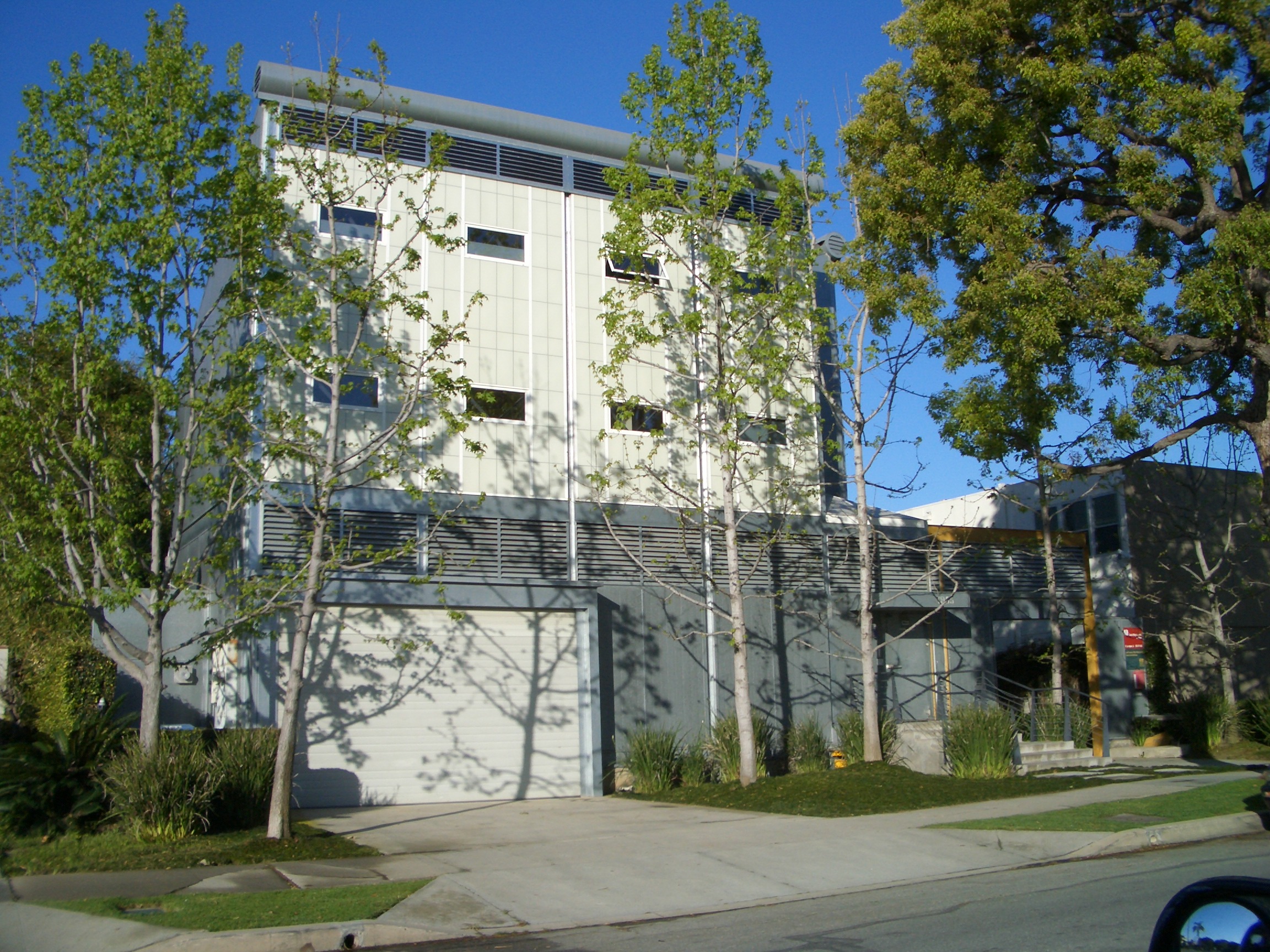
“It was a very gentle rocking”
David’s impression during the Northridge disaster in 1994/ LA Times, February 13, 1994
Challenge
The severe seismic input of California earthquake 1994 (UBC97 was considered for the upgraded Base Control System) required a detailed investigation of the structure and its earthquake protection system. It is important to already mention that the site is located approximately 24 km from the Northridge 1994 epicenter. The relatively low weight of the building provides an additional challenge regarding the choice of support locations.
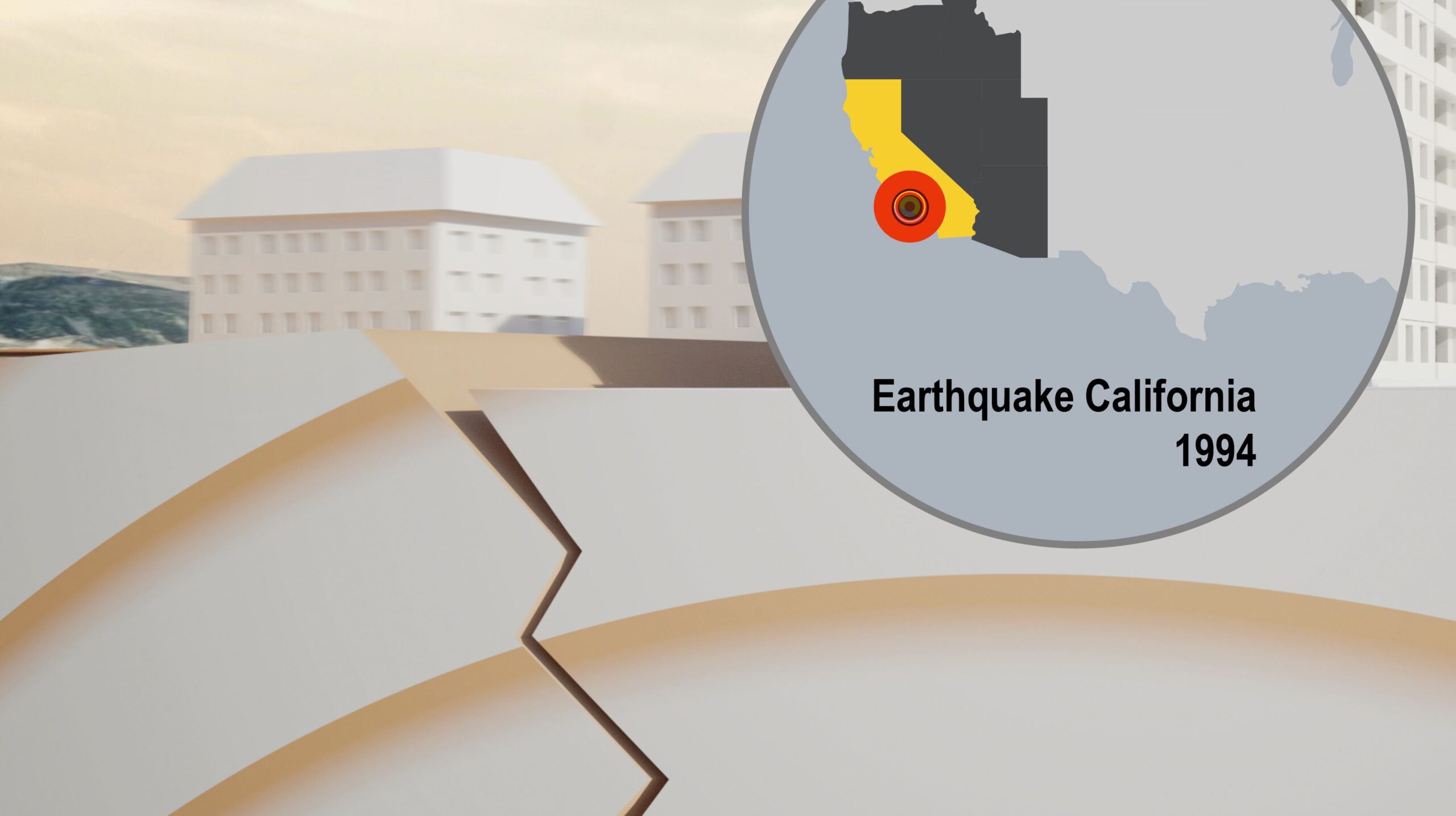
Solution
Initial Base Contol System
During the planning of his new residence, David Ming-Li Lowe already had the seismic risk in his mind and he decided to install a Base Control System as seismic protection measure. The system consists of spring elements and spring-viscodamper® combinations. The spring devices support the weight of the structure and provide stiffness in all three directions. The viscous dampers dissipate energy. More general and detailed information about Base Control Systems can be taken from [1] and [2]. The buildings were severely shaken by the 1994 Northridge Earthquake (January 17, 1994, moment magnitude Mw = 6.7) and withstood without any major structural damage. Unfortunately, some structural details were installed, e.g., glass blocks in the seismic gap, and the garage door fixation was bolted to the substructure without paying attention that the structure moves in all three directions due to the flexibility of the spring devices. Thus, some small local damage occured. Here, it is important to have in mind, that these more or less neglicable damage must not be used to question the excellent protection efficiency of the Base Control System. For further information please also refer to [3].
Technical Facts:
Structure: Braced steel frame structure
Vibration source: Seismic
Solution: GERB 3-D Base Control System
Completion: 1991
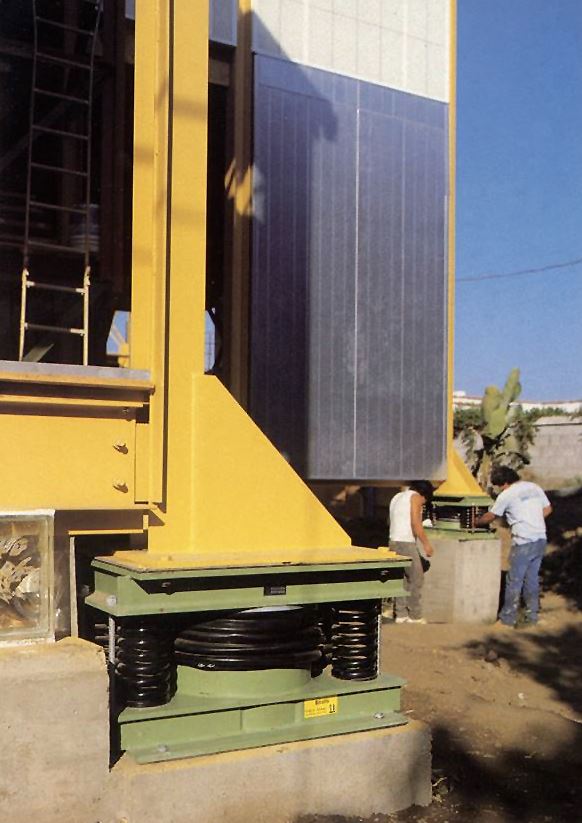
Upgraded Base Control System
On the one hand, the study of the earthquake behavior increased the confidence in the effective operation of the installed protection system; on the other hand, additional questions were raised: how to consider more stringent seismic requirements due to revision of seismic standard / possibility of further optimization of the support
system.
In 2004 the system was investigated in detail again and an improved Base Control System was developped, designed, manufactured and
installed, using the important advange that the devices are replaceable easily. Due to the arrangement of spring elements with a higher ratio between vertical and horizontal stiffness and due to the arrangement of optimized viscous dampers the seismic behaviour was further improved. Imporant structural responses (e.g. absolute accelerations in all 3 directions, internal forces and subsoil reactions) are reduced significantly.
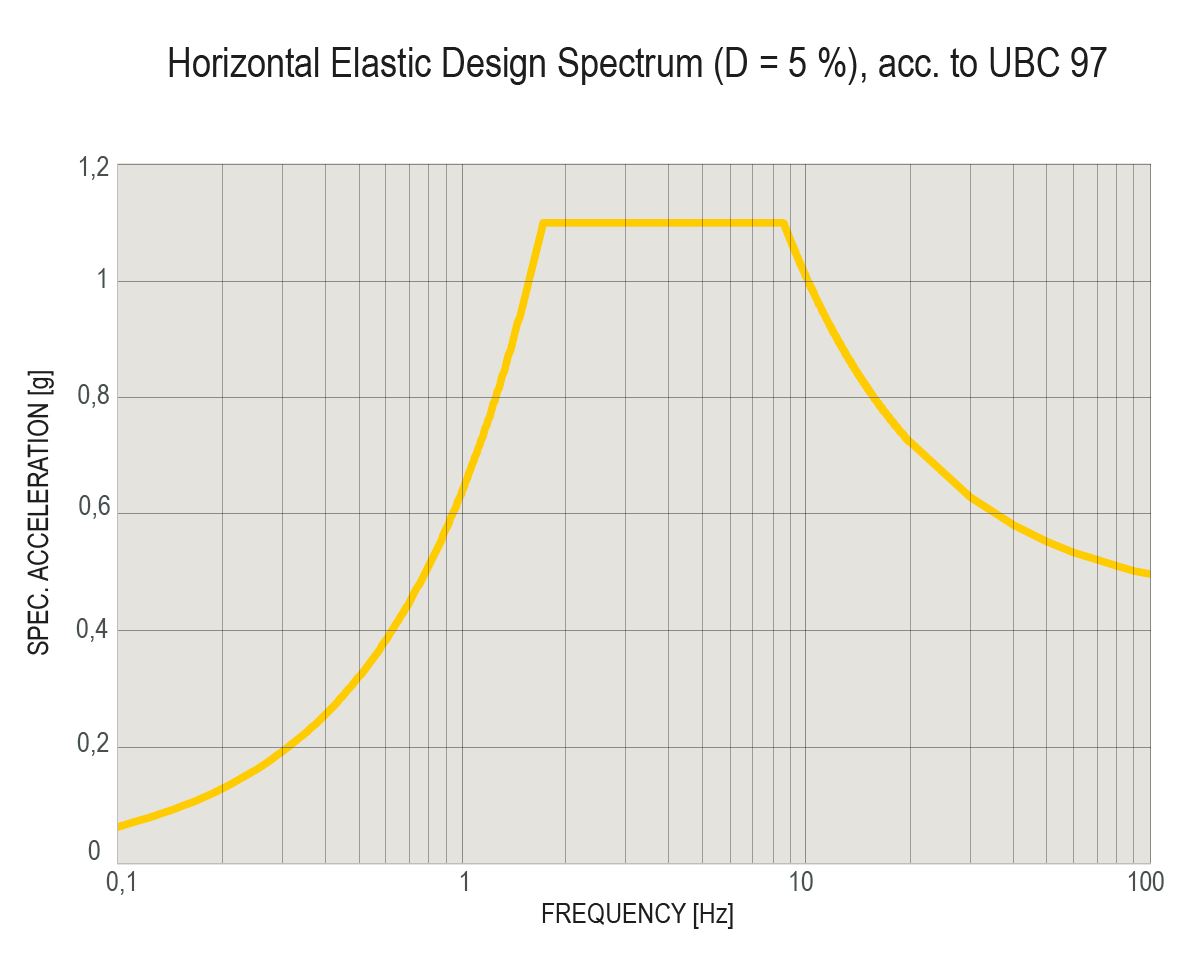
The chosen devices provide an important advantage due to their prestressibility. This feature allows not only the easy adjustment (by adding or removing steel shims) but also the simple replacement, if required. Thus, it is possible to exchange each single element step by step, by using a hydraulic jack system at each location. It is not required to lift the entire structure.
A comparison of an unprotected structure, the structure based on the
initially installed Base Control System (BCS) and the improved BCS
are summarized in the table, showing an excerpt of typical responses.
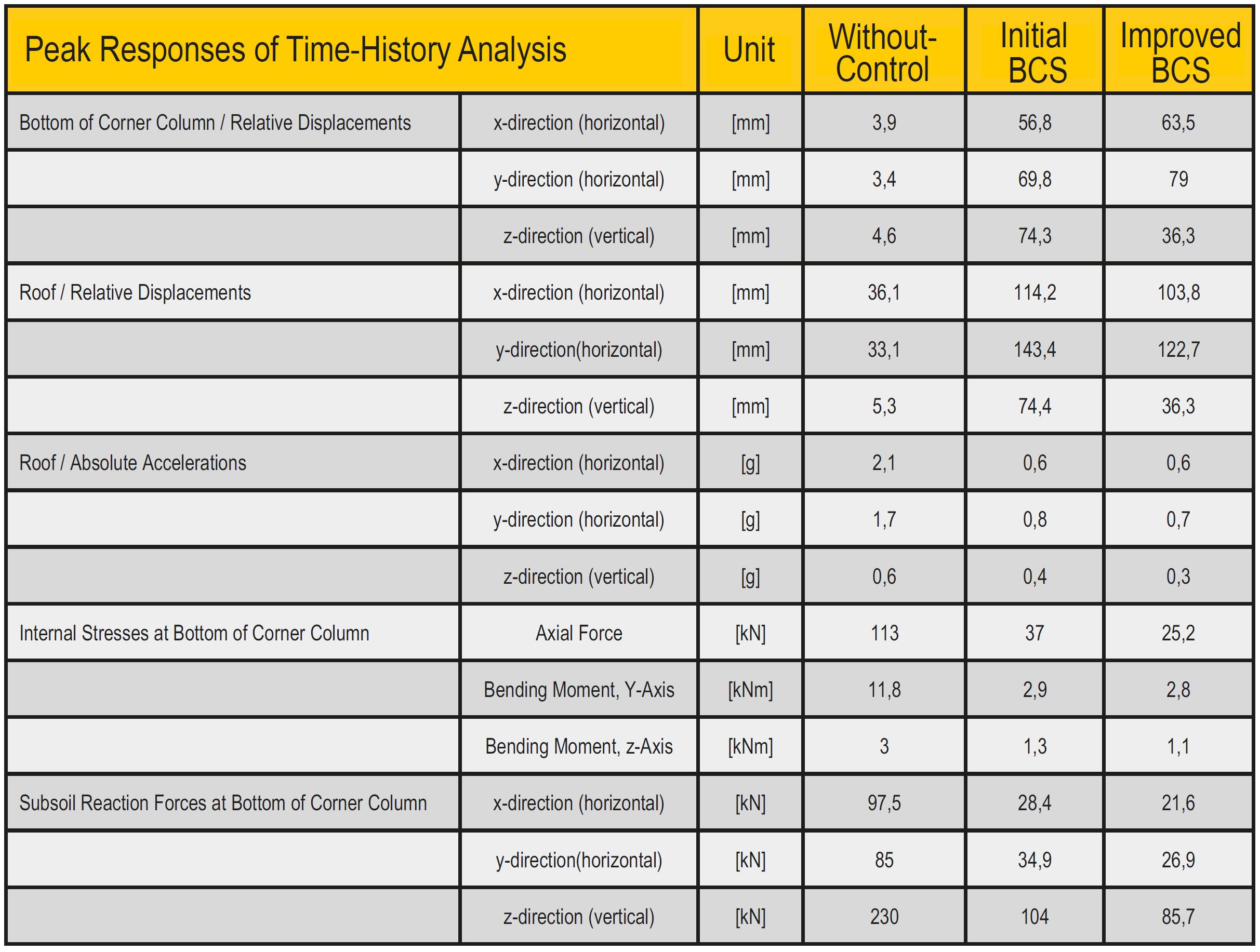
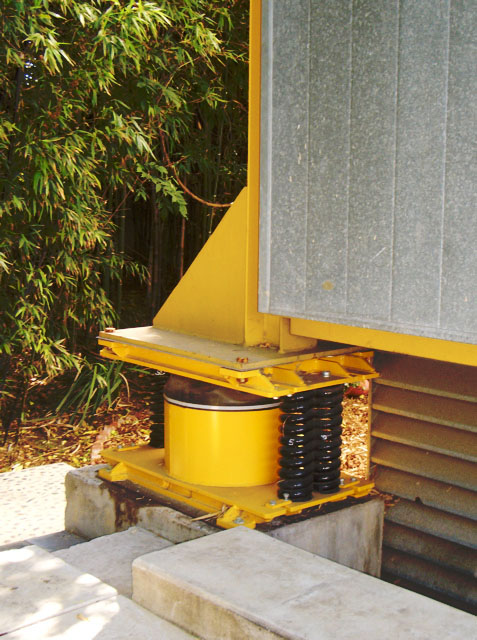
Result
1) Measurements during the Northridge event in 1994 have shown that the installed Base Control System worked well. The system was in excellent condition in 2004.
2) The performance of the initial system was further improved.
- Increase of seismic safety (Collapse prevention / subsoil loads)
- Improvement of serviceability (Reduction of damage during a severe seismic event / reduction of repair cost)
- Improved stiffness ratio of the spring system
- Less sensitivity to changes of dead loads
- Minimum rocking in case of earthquakes
- Optimized spring-viscodamper® system
- Adjustment to higher dead weight (Measured)
- Adjustment to actual load distribution (Displacements measurement)
- Consideration of changed earthquake demands (initial design was based on UBC ’88)
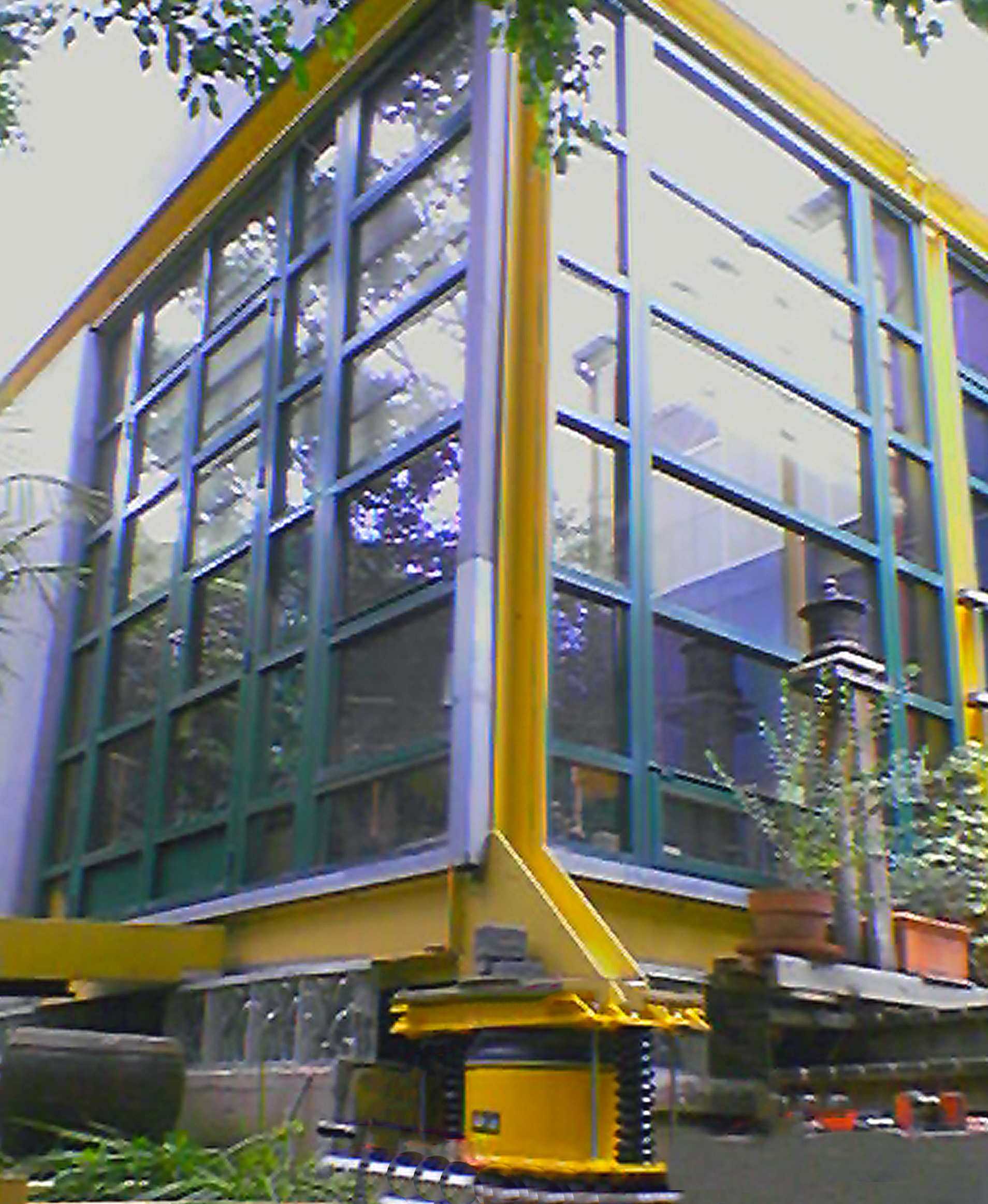
3) The „New“ Base Control System was successfully installed in September 2004.
REFERENCES:
[1] Nawrotzki, P., Salcedo, V., Siepe, D.: 3-D Base Control Systems for the Seismic Protection of Power Plant Equipment and Buildings. In SMiRT-22, 1-8, San Francisco, USA (2013).
[2] Siepe, D., Nawrotzki, P. : Horizontal and vertical isolation of seismic and aircraft impact. In: 14th World Conference on Seismic Isolation, Energy Dissipation and Active Vibration Control of Structures, San Diego, USA, (2015).
[3] Makris, N., Deoskar, H. S.: Prediction of observed response of base-isolated structure. In: Journal of Structural Engineering, Pages 485-493, (05/1996)
Further Resources
You need further information on this topic?
Please do not hesitate to contact us with your individual question.
One of our project engineers will get back to you shortly.
Withstanding past and future earthquakes with a 3-D Base Control System in California
David Lowe Residences, USA
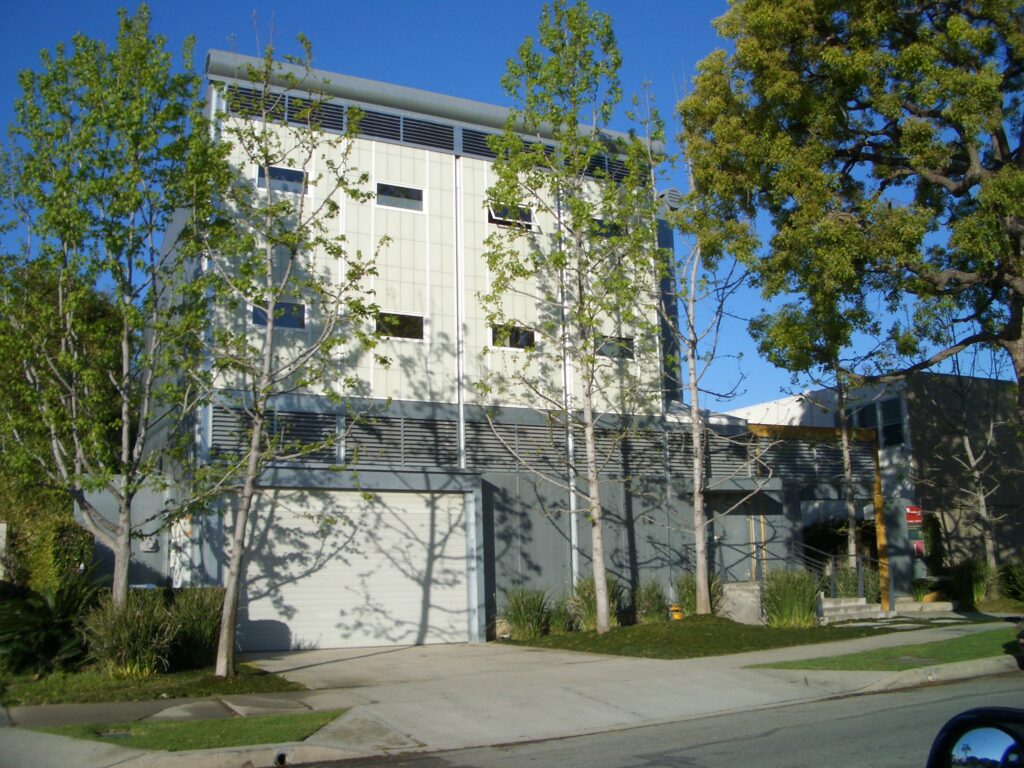
“It was a very gentle rocking”
David’s impression during the Northridge disaster in 1994/ LA Times, February 13, 1994
The famous and award-winning american architect David Ming-Li Lowe (1954-2013) designed and built two identical buildings with 3-story steel braced frame structures located in West Los Angeles. The architect’s own home, built in 1990, is a masterpiece of residential design utilizing industrial technology and components. The building dimensions are approximately 12.8 x 12.8 m in plan, with a height of about 9 m. During the initial design the seismic mass was assumed with 62.5 metric tons. David Ming-Li Lowe designed buildings that were earthquake resistant and for these two current residences he introduced and applied the GERB 3-D Base Control System (BCS).
Withstanding past and future earthquakes with a 3-D Base Control System in California
David Lowe Residences, USA
The famous and award-winning american architect David Ming-Li Lowe (1954-2013) designed and built two identical buildings with 3-story steel braced frame structures located in West Los Angeles. The architect’s own home, built in 1990, is a masterpiece of residential design utilizing industrial technology and components. The building dimensions are approximately 12.8 x 12.8 m in plan, with a height of about 9 m. During the initial design the seismic mass was assumed with 62.5 metric tons. David Ming-Li Lowe designed buildings that were earthquake resistant and for these two current residences he introduced and applied the GERB 3-D Base Control System (BCS).
“It was a very gentle rocking”
David’s impression during the Northridge disaster in 1994/ LA Times, February 13, 1994

Challenge
The severe seismic input of California earthquake 1994 (UBC97 was considered for the upgraded Base Control System) required a detailed investigation of the structure and its earthquake protection system. It is important to already mention that the site is located approximately 24 km from the Northridge 1994 epicenter. The relatively low weight of the building provides an additional challenge regarding the choice of support locations.
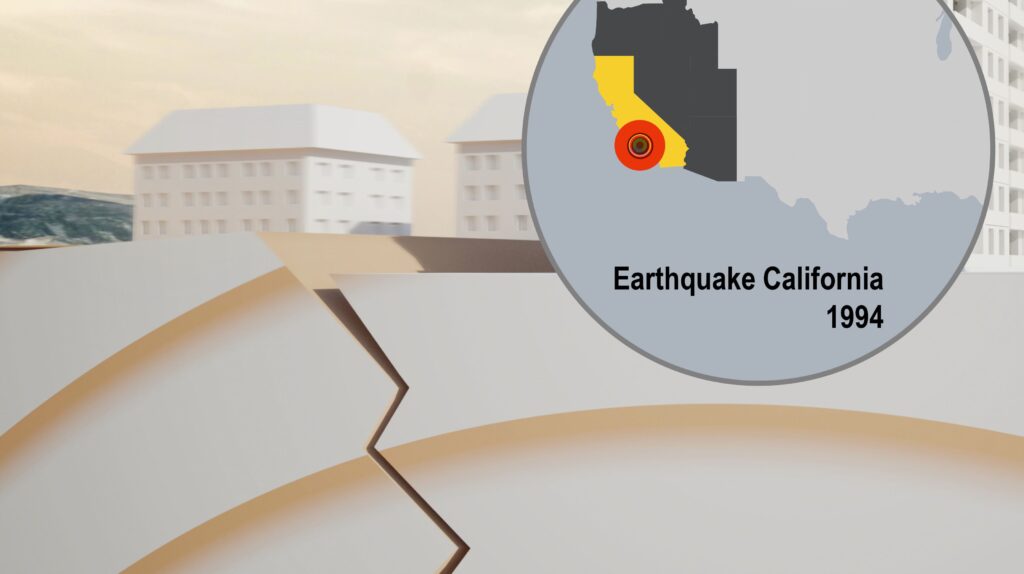
Challenge
The severe seismic input of California earthquake 1994 (UBC97 was considered for the upgraded Base Control System) required a detailed investigation of the structure and its earthquake protection system. It is important to already mention that the site is located approximately 24 km from the Northridge 1994 epicenter. The relatively low weight of the building provides an additional challenge regarding the choice of support locations.

Solution
Initial Base Contol System
During the planning of his new residence, David Ming-Li Lowe already had the
seismic risk in his mind and he decided to install a Base Control System as seismic
protection measure. The system consists of spring elements and spring-viscodamper® combinations. The spring devices support the weight of the structure and provide
stiffness in all three directions. The viscous dampers dissipate energy. More general and detailed information about Base Control Systems can be taken from [1] and [2]. The buildings were severely shaken by the 1994 Northridge Earthquake (January 17, 1994, moment magnitude Mw = 6.7) and withstood without any major structural damage. Unfortunately, some structural details were installed, e.g., glass blocks in the seismic gap, and the garage door fixation was bolted to the substructure without paying attention that the structure moves in all three directions due to the flexibility of the spring devices. Thus, some small local damage occured. Here, it is important to have in mind, that these more or less neglicable damage must not be used to question the excellent protection efficiency of the Base Control System. For further information please also refer to [3].
Technical Facts:
Structure: Braced steel frame structure
Vibration source: Seismic
Solution: 3-D Base Control System
Completion: 1991

Upgraded Base Control System
On the one hand, the study of the earthquake behavior increased the confidence in the effective operation of the installed protection system; on the other hand, additional questions were raised: how to consider more stringent seismic requirements due to revision of seismic standard / possibility of further optimization of the support system. In 2004 the system was investigated in detail again and an improved Base Control System was developped, designed, manufactured and installed, using the important advange that the devices are replaceable easily. Due to the arrangement of spring elements with a higher ratio between vertical and horizontal stiffness and due to the arrangement of optimized viscous dampers the seismic behaviour was further improved. Imporant structural responses (e.g. absolute accelerations in all 3 directions, internal forces and subsoil reactions) are reduced significantly.

The chosen devices provide an important advantage due to their prestressibility. This feature allows not only the easy adjustment (by adding or removing steel shims) but also the simple replacement, if required. Thus, it is possible to exchange each single element step by step, by using a hydraulic jack system at each location. It is not required to lift the entire structure.
A comparison of an unprotected structure, the structure based on the initially installed Base Control System (BCS) and the improved BCS are summarized in the table, showing an excerpt of typical responses.

Result
1) Measurements during the Northridge event in 1994 have shown that the installed Base Control System worked well. The system was in excellent condition in 2004.
2) The performance of the initial system was further improved.
- Increase of seismic safety (Collapse prevention / subsoil loads)
- Improvement of serviceability (Reduction of damage during a severe seismic event / reduction of repair cost)
- Improved stiffness ratio of the spring system
- Less sensitivity to changes of dead loads
- Minimum rocking in case of earthquakes
- Optimized spring-viscodamper® system
- Adjustment to higher dead weight (Measured)
- Adjustment to actual load distribution (Displacements measurement)
- Consideration of changed earthquake demands (initial design was based on UBC ’88)
3) The „New“ Base Control System was successfully installed in September 2004.

REFERENCES:
[1] Nawrotzki, P., Salcedo, V., Siepe, D.: 3-D Base Control Systems for the Seismic Protection of Power Plant Equipment and Buildings. In SMiRT-22, 1-8, San Francisco, USA (2013).
[2] Siepe, D., Nawrotzki, P. : Horizontal and vertical isolation of seismic and aircraft impact. In: 14th World Conference on Seismic Isolation, Energy Dissipation and Active Vibration Control of Structures, San Diego, USA, (2015).
[3] Makris, N., Deoskar, H. S.: Prediction of observed response of base-isolated structure. In: Journal of Structural Engineering, Pages 485-493, (05/1996)
Solution
Initial Base Contol System
During the planning of his new residence, David Ming-Li Lowe already had the seismic risk in his mind and he decided to install a Base Control System as seismic protection measure. The system consists of spring elements and spring-viscodamper® combinations. The spring devices support the weight of the structure and provide stiffness in all three directions. The viscous dampers dissipate energy. More general and detailed information about Base Control Systems can be taken from [1] and [2]. The buildings were severely shaken by the 1994 Northridge Earthquake (January 17, 1994, moment magnitude Mw = 6.7) and withstood without any major structural damage. Unfortunately, some structural details were installed, e.g., glass blocks in the seismic gap, and the garage door fixation was bolted to the substructure without paying attention that the structure moves in all three directions due to the flexibility of the spring devices. Thus, some small local damage occured. Here, it is important to have in mind, that these more or less neglicable damage must not be used to question the excellent protection efficiency of the Base Control System. For further information please also refer to [3].
Technical Facts:
Structure: Braced steel frame structure
Vibration source: Seismic
Solution: 3-D Base Control System
Completion: 1991

Upgraded Base Control System
On the one hand, the study of the earthquake behavior increased the confidence in the effective operation of the installed protection system; on the other hand, additional questions were raised: how to consider more stringent seismic requirements due to revision of seismic standard / possibility of further optimization of the support system. In 2004 the system was investigated in detail again and an improved Base Control System was developped, designed, manufactured and installed, using the important advange that the devices are replaceable easily. Due to the arrangement of spring elements with a higher ratio between vertical and horizontal stiffness and due to the arrangement of optimized viscous dampers the seismic behaviour was further improved. Imporant structural responses (e.g. absolute accelerations in all 3 directions, internal forces and subsoil reactions) are reduced significantly.

The chosen devices provide an important advantage due to their
prestressibility. This feature allows not only the easy djustment (by adding or removing steel shims) but also the simple replacement, if required. Thus, it is possible to exchange each single element step by step, by using a hydraulic jack system at each location. It is not required to lift the entire structure.
A comparison of an unprotected structure, the structure based on the initially installed Base Control System (BCS) and the improved BCS are summarized in the table, showing an excerpt of typical responses.

Result
1) Measurements during the Northridge event in 1994 have shown that the installed Base Control System worked well. The system was in excellent condition in 2004.
2) The performance of the initial system was further improved.
- Increase of seismic safety (Collapse prevention / subsoil loads)
- Improvement of serviceability (Reduction of damage during a severe seismic event / reduction of repair cost)
- Improved stiffness ratio of the spring system
- Less sensitivity to changes of dead loads
- Minimum rocking in case of earthquakes
- Optimized spring-viscodamper® system
- Adjustment to higher dead weight (Measured)
- Adjustment to actual load distribution (Displacements measurement)
- Consideration of changed earthquake demands (initial design was based on UBC ’88)
3) The „New“ Base Control System was successfully installed in September 2004.
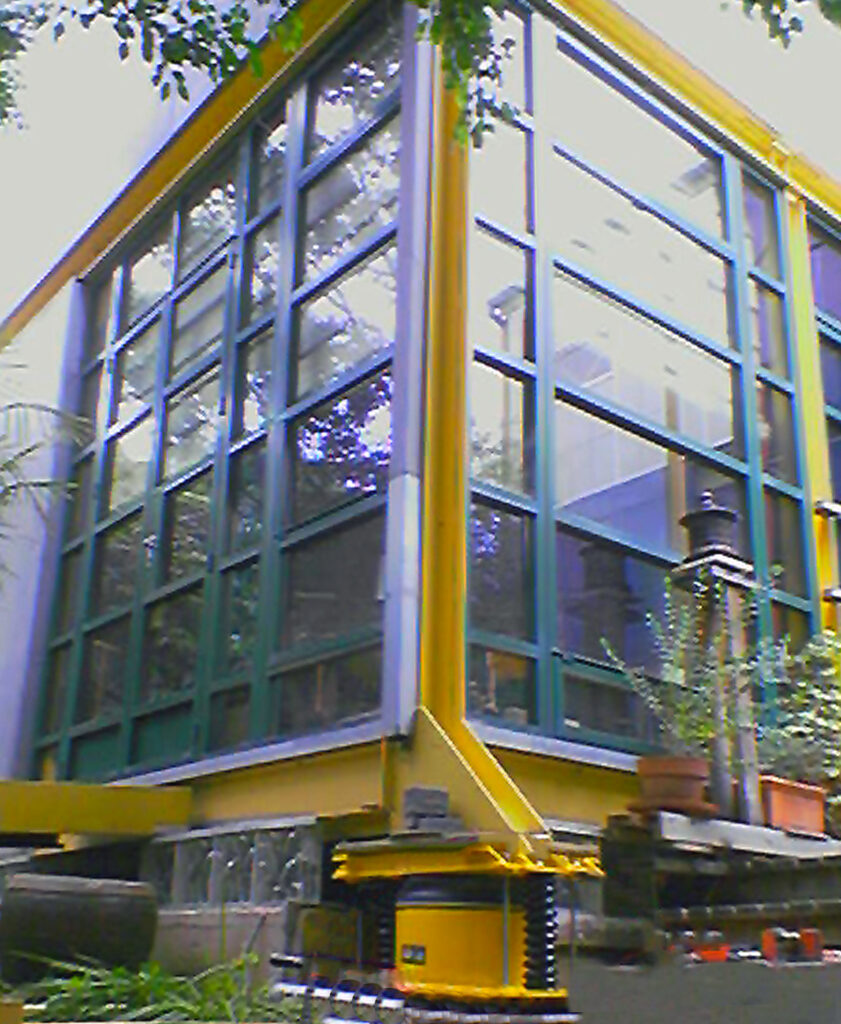
REFERENCES:
[1] Nawrotzki, P., Salcedo, V., Siepe, D.: 3-D Base Control Systems for the Seismic Protection of Power Plant Equipment and Buildings. In SMiRT-22, 1-8, San Francisco, USA (2013).
[2] Siepe, D., Nawrotzki, P. : Horizontal and vertical isolation of seismic and aircraft impact. In: 14th World Conference on Seismic Isolation, Energy Dissipation and Active Vibration Control of Structures, San Diego, USA, (2015).
[3] Makris, N., Deoskar, H. S.: Prediction of observed response of base-isolated structure. In: Journal of Structural Engineering, Pages 485-493, (05/1996)
Share this post
Further Resources
You need further information on this topic?
Please do not hesitate to contact us with your individual question.
One of our project engineers will get back to you shortly.
Further Resources
You need further information on this topic?
Please do not hesitate to contact us with your individual question.
One of our project engineers will get back to you shortly.